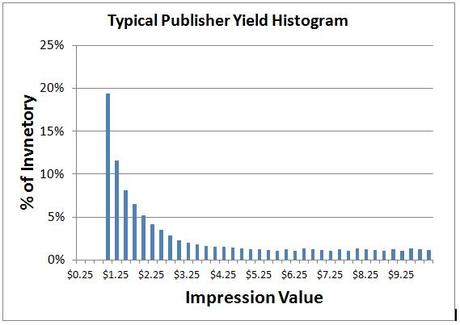To exist on the advertising market and to best embrace the digital revolution, publishers need to regain control of the technology behind: whether homebuilt or professional, this advertising platform should be fully integrated, programmatic enabled, and data-safe in order to best generate higher revenue and protect publishers’ margin. Here’s why.
Publishers’ position in the advertising industry, the “rich-richer economy”, is uncertain
Publishers are facing several challenges: although the display advertising market is growing, publishers haven’t yet earned the most advertising dollars or taken advantage of new opportunities.
. Even though the digital ad-supported revenue model is doing well, the display supply-side market is highly concentrated and dominated by a few global players that take the lion ‘s share: Display ad spending is expected to grow 76% by 2017, according to Emarketer’s forecasts, and 6 ad-selling companies are expected to get 56% of display dollars in US in 2013.
. Publishers’ bargaining power in the supply & demand game has decreased over the last few years.
On the one hand, major media buyers are increasingly willing to reach a wide-scale audience, beyond the reach of premium publishers.
On the other hand, publishers are more dependent on technology suppliers that are also direct competitors in terms of audience. These suppliers are increasingly involved in the different stages of publishers’ business value chain: as main traffic sources, main advertising technology partners or main media traders. This trend is to stay:
[The death of the cookies] creates a situation where you could have a couple of players, namely Google and Facebook, just take over and have so much power where it’s not good for the industry” as Lamberti, Adtruth CEO puts it.
. Publishers have lost control of key factors for digital success. They have been both unwillingly (in case of data leakage, see below) and willingly stripped of their power (to monetize their unsold inventory, publishers have relied and become dependent on 3rd party performance partners without having any leverage to really challenge them).
The growth in digital ad spending, driven by mobile, video native & programmatic advertising, is a huge opportunity of which publishers could take better advantage, but only on condition that they regain control of their advertising operations.
Publishers have already begun to do so. A number of leading publishers have already launched their private ad-exchanges using 3rd party solutions. Others, such as Dailymotion (second largest online video platform in the world), are already migrating to their own homebuilt solution.
3 reasons why publishers should regain control over their advertising operations:
1) Publisher should maximize revenue by regaining control of their first impression
Not every impression has the same value (see graph below)

Source : http://www.adopsinsider.com/ad-serving/what-is-holistic-ad-serving/
Many factors can account for this price difference (context, placement, audience…) but the main factor is that the first impression triggered when a new-user visits your website is much more valuable than all others.
That’s why many third party actors are competing to maximize the chance of accessing this first impression, either by being granted a priority access (or first look or private deals) before the rest of the market, or usually by means of a bulk offer for a flat CPM.
Publishers should limit “the middleman” effect, whereby they allow a third party to monetize a significant part of its inventory at low yield, without taking into account this inventory’s disparity and without realizing how much its most prized asset, the first impression, is really worth.
Optimizing your monetized yield revenue implies optimizing your most valuable impressions: keep control of your 1st impression to enable all of your demand sources (whether premium, programmatic or performance sources) compete in real time at the impression level and win the highly valued 1st impression auction.

In doing so, publishers can generate more revenue, by making the most of their inventory. This is particularly true given that a private ad exchange is scalable, enabling publishers to reach thousands of buyers at low marginal cost and achieve higher margins by avoiding 3rd parties.
Technically speaking, the only way of maintaining control of one’s first impression is by opting for an RTB platform that is fully integrated in its ad server (holistic ad serving). Opting for an integrated solution also allows a more granular level of control of inventory and business rules (blocklists, floors, etc.)
2) Publishers should regain control of their data and insofar as possible prevent third parties from disrupting their business model
Typically a leak appears when a 3rd party is able to match user-information (cookie) with publisher contextual data, thus enriching his own user profiles database.
This data can later be used by third parties out of the publisher’s reach, in order to resell cheaper external ad placements to ad buyers willing to retarget this audience.
Consequently, a publisher’s main advertising model (where premium inventory value= premium placement x premium content x qualified audience) is disrupted. Publishers’ revenue is endangered given that it entails decreased revenue in the short term and facilitates advertisers finding external and cheaper media combined with the publisher’s good first party data. Advertisers therefore won’t be willing to keep paying good money in the long term.
Data leakage is a crucial concern that is damaging the industry: leakage is reported to have increased by 400% in 2012. More than 50% of data collection at publisher sites should be now coming from parties over whom the publisher has no direct control or relationship.
Regaining control of data, by auditing their site, and choosing a technology partner that doesn’t leak data, should be among publishers’ top priorities as these will enable them to charge higher CPM afterwards.
Putting an end to data leakage works :
A few months after blocking leaks, an increasing number of advertisers started contacting the news sites in the group directly.”
3) By regaining control, publishers can secure a long term position in the fast-paced ecosystem
By building a private ad exchange, publishers can strengthen their brand and develop long term relationships with their direct buyers, regardless of the sales channel advertisers use.
For instance, Dailymotion was able to build relationships with advertisers in Asia, a region in which they didn’t yet have a human presence.
